MENU
The Electronic Scholarly Publishing Project: Providing access to classic scientific papers and other scholarly materials, since 1993. More About: ESP | OUR CONTENT | THIS WEBSITE | WHAT'S NEW | WHAT'S HOT
Comparative Timelines
The ESP Timeline (one of the site's most popular features) has been completely updated to allow the user to select (using the timeline controls above each column) different topics for the left and right sides of the display.
Select:
New Left Column
New Left Column
Dates
Decade
New Right Column
New Right Column
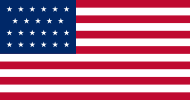 The US flag is modified to have twenty-three stars, reflecting the addition of two new states: Alabama and Maine.
The US flag is modified to have twenty-three stars, reflecting the addition of two new states: Alabama and Maine.
Debate over slavery in the US heats up; The Missouri Compromise admits Maine into the Union as a free state, with Missouri to enter the next year as a slave state. Slavery is banned north of the 36 30' line of latitude in the Louisiana Territory.
Missouri Compromise Missouri is admitted to the Union as a slave state, Maine as a free state. Slavery is forbidden in any subsequent territories north of latitude .
The Arithmometer was the first commercially successful mechanical calculator patented
The first Christian missionaries arrived in the Hawaiian Islands.
 Christian Friedrich Nasse formulated Nasse's law: hemophilia occurs only in males and is passed on by unaffected females.
Christian Friedrich Nasse formulated Nasse's law: hemophilia occurs only in males and is passed on by unaffected females.
Gideon Mantell discovers, in England, a fossil trunk of a tree resembling that of a tropical palm, evidence of a much warmer climate.
 André-Marie Ampère formulates one of the basic laws of electromagnetism, the right-hand rule for the influence of an electric current on the magnet and demonstrates that two wires that are carrying an electric current will attract or repel each other, depending on whether the occurrence are in opposite where the same directions.
André-Marie Ampère formulates one of the basic laws of electromagnetism, the right-hand rule for the influence of an electric current on the magnet and demonstrates that two wires that are carrying an electric current will attract or repel each other, depending on whether the occurrence are in opposite where the same directions.
 Dominique-François Arago discovers the magnetic effect of electricity passing through a copper wire, demonstrating that iron is not necessary for magnetism.
Dominique-François Arago discovers the magnetic effect of electricity passing through a copper wire, demonstrating that iron is not necessary for magnetism.
 Augustin-Jean Fresnel invents the so-called Fresnel lens, a lens used in lighthouses.
Augustin-Jean Fresnel invents the so-called Fresnel lens, a lens used in lighthouses.
 The science of electrodynamics is born with the announcement of Hans Christian Ørsted's discovery of electromagnetism.
The science of electrodynamics is born with the announcement of Hans Christian Ørsted's discovery of electromagnetism.
1820
(no entry for this year)
 Michael Faraday invents the electric motor and generator.
Michael Faraday invents the electric motor and generator.
1821
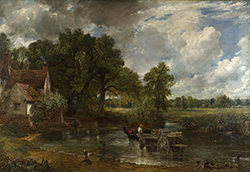 Painting by John Constable: The Hay Wain depicts a rural scene on the River Stour between the English counties of Suffolk and Essex. It hangs in the National Gallery in London and is regarded as "Constable's most famous image" and one of the greatest and most popular English paintings. Painted in oils on canvas, the work depicts as its central feature three horses pulling what in fact appears to be a wood wain or large farm cart across the river. Willy Lott's Cottage, also the subject of an eponymous painting by Constable, is visible on the far left. The scene takes place near Flatford Mill in Suffolk, though since the Stour forms the border of two counties, the left bank is in Suffolk and the landscape on the right bank is in Essex.
Painting by John Constable: The Hay Wain depicts a rural scene on the River Stour between the English counties of Suffolk and Essex. It hangs in the National Gallery in London and is regarded as "Constable's most famous image" and one of the greatest and most popular English paintings. Painted in oils on canvas, the work depicts as its central feature three horses pulling what in fact appears to be a wood wain or large farm cart across the river. Willy Lott's Cottage, also the subject of an eponymous painting by Constable, is visible on the far left. The scene takes place near Flatford Mill in Suffolk, though since the Stour forms the border of two counties, the left bank is in Suffolk and the landscape on the right bank is in Essex.
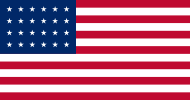 The US flag is modified to have twenty-four stars, reflecting the addition of one new state: Missouri.
The US flag is modified to have twenty-four stars, reflecting the addition of one new state: Missouri.
Slave Revolt: South Carolina Freed slave Denmark Vesey attempts a rebellion in Charleston. Thirty-five participants in the ill-fated uprising are hanged.
Charles Babbage takes first steps in the construction of machines that would compute numbers
 Nicéphore Niépce abandons silver halide photography as hopelessly impermanent and tries using thin coatings of Bitumen of Judea on metal and glass. He creates the first fixed, permanent photograph, a copy of an engraving of Pope Pius VII, by contact printing in direct sunlight without a camera or lens. It is later destroyed; the earliest surviving example of his "heliographic process" is from 1825.
Nicéphore Niépce abandons silver halide photography as hopelessly impermanent and tries using thin coatings of Bitumen of Judea on metal and glass. He creates the first fixed, permanent photograph, a copy of an engraving of Pope Pius VII, by contact printing in direct sunlight without a camera or lens. It is later destroyed; the earliest surviving example of his "heliographic process" is from 1825.
Etienne Geoffroy publishes Anatomical Philosophy discussing similarities between skeletal structures — such as bat wings, paws and hands — that support the evolutionary claims of Lamarck. He also argues that arthropods and vertebrates have similar but inverse body plans, an assertion that will ultimately be widely accepted.
 Between 1822-1824, Thomas Andrew Knight, John Goss, and Alexander Seton all independently perform crosses with the pea and observe dominance in the immediate progeny, and segregation of various hereditary characters in the next generation. However, they do not study later generations or determine the numerical ratios in which the characters are transmitted.
Between 1822-1824, Thomas Andrew Knight, John Goss, and Alexander Seton all independently perform crosses with the pea and observe dominance in the immediate progeny, and segregation of various hereditary characters in the next generation. However, they do not study later generations or determine the numerical ratios in which the characters are transmitted.
William Buckland publishes an account of how ancient hyenas lived and fed in Kirkdale Cave, based on their fossil remains. This is one of the first descriptions of living habits based on fossil evidence.
Omalius d'Halloy names the Cretaceous System, after massive chalk deposits. This time period will later be identified with the last dinosaurs and the first flowering plants.
William Conybeare and William Phillips name the Carboniferous System, a period associated with coal deposits. This time period will also become known as the Mississippian and Pennsylvanian Periods in the United States.
1822
(no entry for this year)
Slavery is abolished in Chile.
 Physicist Michael Faraday (1791-1867) describes the liquification of chlorine in On fluid chlorine. Faraday finds that gasses of certain kinds, when kept under constant pressure, will condense until they cool. This latter discovery ushers in the beginning of mechanical methods of refrigeration.
Physicist Michael Faraday (1791-1867) describes the liquification of chlorine in On fluid chlorine. Faraday finds that gasses of certain kinds, when kept under constant pressure, will condense until they cool. This latter discovery ushers in the beginning of mechanical methods of refrigeration.
Small-scale drilling for oil begins at Baku, a Russian port city on the west coast of the Caspian Sea, now the capital of Azerbaijan. The drilling marks the beginning of the modern petroleum industry, and by 1900 nearly half the world's oil will come from the Baku oil fields.
 Thomas Andrew Knight confirms reports of dominance, recessivity, and segregation in peas, but does not detect regularities.
Thomas Andrew Knight confirms reports of dominance, recessivity, and segregation in peas, but does not detect regularities.
William Buckland finds a skeleton covered in ocher. Called the Red Lady, it will later be identified as Cro-Magnon (and male).
1823
(no entry for this year)
Mexico outlaws slavery. This decision creates the incentive for Anglo Texans to fight for independence in 1835-1836.
 Nicéphore Niépce makes the first durable, light-fast camera photograph, similar to his surviving 1826-1827 photograph on pewter but created on the surface of a lithographic stone. It is destroyed in the course of subsequent experiments.
Nicéphore Niépce makes the first durable, light-fast camera photograph, similar to his surviving 1826-1827 photograph on pewter but created on the surface of a lithographic stone. It is destroyed in the course of subsequent experiments.
Mexico becomes a republic, three years after declaring independence from Spain.
William Buckland publishes Notice on the Megalosaurus ("giant lizard"), the first dinosaur fossil to be described and named, although the term "dinosaur" doesn't yet exist. Buckland also announces the discovery of the first fossil mammal from the Mesozoic.
 Réflexions sur la puissance motrice du feu (On the motive power of fire) by Nicolas Léonard Sadi Carnot shows that work is done as heat passes from a high temperature to a low temperature; defines work; hints at the second law of thermodynamics; and suggests internal combustion engines.
Réflexions sur la puissance motrice du feu (On the motive power of fire) by Nicolas Léonard Sadi Carnot shows that work is done as heat passes from a high temperature to a low temperature; defines work; hints at the second law of thermodynamics; and suggests internal combustion engines.
1824
(no entry for this year)
 The Diary of Samuel Pepys is published in Britain. Pepys (1633-1703) had been a secretary of the Admiralty, a member of Parliament, and President of the Royal Society, and his Diary presents an important and entertaining picture of London during the Restoration period.
The Diary of Samuel Pepys is published in Britain. Pepys (1633-1703) had been a secretary of the Admiralty, a member of Parliament, and President of the Royal Society, and his Diary presents an important and entertaining picture of London during the Restoration period.
The Erie Canal (from Albany to Buffalo, New York) opens on October 26, connecting the Midwestern U.S. with the Atlantic Ocean, via the Great Lakes, and stimulating the development of Fort Dearborn (know today as Chicago), Cleveland and Columbus Ohio, and upstate New York cities like Rochester, Syracuse and Little Falls.
The first passenger steam railway opens, between Stockton and Darlington, England.
 John Quincy Adams becomes the sixth president of the United States.
John Quincy Adams becomes the sixth president of the United States.
Father John MacEnery starts digging in Kent's Cave in Devon. He'll eventually find human remains in the same layer as those of extinct mammals, a finding that will be dismissed by Buckland.
Gideon Mantell publishes Notice on the Iguanodon, the second description of a dinosaur and the first description of an herbivorous fossil reptile.
1825
(no entry for this year)
 The Last of the Mohicans, by James Fenimore Cooper, is published.
The Last of the Mohicans, by James Fenimore Cooper, is published.
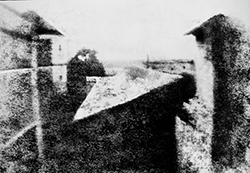 Photograph by Joseph Ni pce: View from the Window at Le Gras, the world's first permanent photograph.
Photograph by Joseph Ni pce: View from the Window at Le Gras, the world's first permanent photograph.
 The first photographic images produced by Joseph-Nicéphore Ni pce
The first photographic images produced by Joseph-Nicéphore Ni pce
1826
(no entry for this year)
 Karl Ernst von Baer first demonstrated the mammalian ovum; he regarded the sperm cells as "Entozoa," i.e., parasites, and named them spermatozoa.
Karl Ernst von Baer first demonstrated the mammalian ovum; he regarded the sperm cells as "Entozoa," i.e., parasites, and named them spermatozoa.
 Theory of systems of rays by William Rowan Hamilton is a unification of the study of optics through the principle of "varying action". It contains his correct prediction of conical refraction. When his prediction is verified, he becomes a well-known and is knighted.
Theory of systems of rays by William Rowan Hamilton is a unification of the study of optics through the principle of "varying action". It contains his correct prediction of conical refraction. When his prediction is verified, he becomes a well-known and is knighted.
 While studying the behavior of fluids under a microscope, botanist Robert Brown (1773-1858) discovers what is today called "Brownian motion".
While studying the behavior of fluids under a microscope, botanist Robert Brown (1773-1858) discovers what is today called "Brownian motion".
1827
(no entry for this year)
A year after discovering the mammalian egg cell, Karl Ernst von Baer publishes Entwickelungsgeschichte der Thiere tracing the developmental history of animals.
 Publication of Karl Ernst von Baer's The Embryology of Animals which strongly opposed preformationism.
Publication of Karl Ernst von Baer's The Embryology of Animals which strongly opposed preformationism.
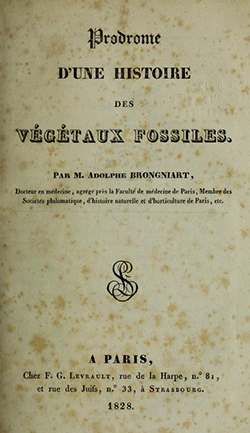 Adolphe Brongniart publishes Prodrome d'une histoire des Végétaux Fossils, a study of fossil plants. He outlines four distinct phases in plant prehistory: (1) primitive plants from the Coal Measures, (2) the first conifers, (3) domination by cycads and conifers, and (4) flowering plants.
Adolphe Brongniart publishes Prodrome d'une histoire des Végétaux Fossils, a study of fossil plants. He outlines four distinct phases in plant prehistory: (1) primitive plants from the Coal Measures, (2) the first conifers, (3) domination by cycads and conifers, and (4) flowering plants.
Mary Anning discovers Britain's first recognized pterosaur fossil. (Gideon Mantell has already found pterosaur remains, but has attributed them to a bird).
 Chemist Friedrich Wöhler (1800-1882) synthesizes the organic compound urea, a feat previously thought impossible because of the vital force thought to be a part of organic substances.
Chemist Friedrich Wöhler (1800-1882) synthesizes the organic compound urea, a feat previously thought impossible because of the vital force thought to be a part of organic substances.
1828
(no entry for this year)
 Chemist James Smithson (1765-1829) bequeaths £100,000 to found the Smithsonian Institution in Washington, D.C. The Institution will be founded in 1846.
Chemist James Smithson (1765-1829) bequeaths £100,000 to found the Smithsonian Institution in Washington, D.C. The Institution will be founded in 1846.
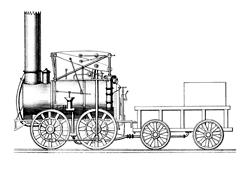 The first steam locomotive to operate on a U.S. railroad begins service between Carbondale and Honesdale, Pennsylvania. The engine, "The Stourbridge Lion", has been imported from the Stephenson Engine Works in London.
The first steam locomotive to operate on a U.S. railroad begins service between Carbondale and Honesdale, Pennsylvania. The engine, "The Stourbridge Lion", has been imported from the Stephenson Engine Works in London.
 Andrew Jackson becomes the seventh president of the United States.
Andrew Jackson becomes the seventh president of the United States.
Slavery abolished in Mexico.
Philippe-Charles Schmerling discovers a Neanderthal fossil, the partial cranium of a small child. The fossil will not be accurately identified as Neanderthal, however, for a century, though Charles Lyell will illustrate it in Antiquity of Man in 1863.
Jules Desnoyers names the Quaternary System, a time in which humans have lived.
 Gustave-Gaspard Coriolis coins the term KINETIC ENERGY in On the calculation of mechanical action.
Gustave-Gaspard Coriolis coins the term KINETIC ENERGY in On the calculation of mechanical action.
 Joseph Henry shows that passing an electric current through a wire wrapped into coils produces a greater magnetic field than is produced when that same current is passed through a straight wire, and that an insulated wire wrapped around an iron core can produce a powerful electromagnet.
Joseph Henry shows that passing an electric current through a wire wrapped into coils produces a greater magnetic field than is produced when that same current is passed through a straight wire, and that an insulated wire wrapped around an iron core can produce a powerful electromagnet.
1829
(no entry for this year)
ESP Quick Facts
ESP Origins
In the early 1990's, Robert Robbins was a faculty member at Johns Hopkins, where he directed the informatics core of GDB — the human gene-mapping database of the international human genome project. To share papers with colleagues around the world, he set up a small paper-sharing section on his personal web page. This small project evolved into The Electronic Scholarly Publishing Project.
ESP Support
In 1995, Robbins became the VP/IT of the Fred Hutchinson Cancer Research Center in Seattle, WA. Soon after arriving in Seattle, Robbins secured funding, through the ELSI component of the US Human Genome Project, to create the original ESP.ORG web site, with the formal goal of providing free, world-wide access to the literature of classical genetics.
ESP Rationale
Although the methods of molecular biology can seem almost magical to the uninitiated, the original techniques of classical genetics are readily appreciated by one and all: cross individuals that differ in some inherited trait, collect all of the progeny, score their attributes, and propose mechanisms to explain the patterns of inheritance observed.
ESP Goal
In reading the early works of classical genetics, one is drawn, almost inexorably, into ever more complex models, until molecular explanations begin to seem both necessary and natural. At that point, the tools for understanding genome research are at hand. Assisting readers reach this point was the original goal of The Electronic Scholarly Publishing Project.
ESP Usage
Usage of the site grew rapidly and has remained high. Faculty began to use the site for their assigned readings. Other on-line publishers, ranging from The New York Times to Nature referenced ESP materials in their own publications. Nobel laureates (e.g., Joshua Lederberg) regularly used the site and even wrote to suggest changes and improvements.
ESP Content
When the site began, no journals were making their early content available in digital format. As a result, ESP was obliged to digitize classic literature before it could be made available. For many important papers — such as Mendel's original paper or the first genetic map — ESP had to produce entirely new typeset versions of the works, if they were to be available in a high-quality format.
ESP Help
Early support from the DOE component of the Human Genome Project was critically important for getting the ESP project on a firm foundation. Since that funding ended (nearly 20 years ago), the project has been operated as a purely volunteer effort. Anyone wishing to assist in these efforts should send an email to Robbins.
ESP Plans
With the development of methods for adding typeset side notes to PDF files, the ESP project now plans to add annotated versions of some classical papers to its holdings. We also plan to add new reference and pedagogical material. We have already started providing regularly updated, comprehensive bibliographies to the ESP.ORG site.
ESP Picks from Around the Web (updated 06 MAR 2017 )
Old Science

Weird Science

Treating Disease with Fecal Transplantation
Fossils of miniature humans (hobbits) discovered in Indonesia

Dinosaur tail, complete with feathers, found preserved in amber.
Astronomy

Mysterious fast radio burst (FRB) detected in the distant universe.